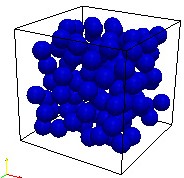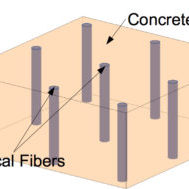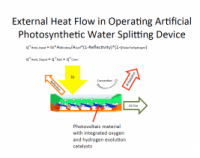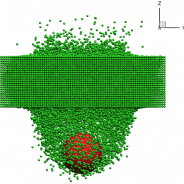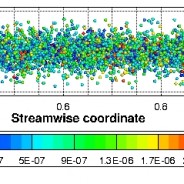Beam Based Modeling of Open-Celled Foams
Research by: Matthew Kurry With modern polymer and composite technology helmets used by military personnel have become so good at preventing death from kinetic impacts that soldiers are surviving attacks that would have killed them before. While more soldiers are surviving, the momentum transfer due to the impact can injure the wearer’s brain. In this research we seek to understand the momentum and energy transfer physics of open-celled foams to better protect helmet wearers. Various projects in this research include the processing of scanned foam images and the used of beam finite elements to simulate impact events in open cells....
read moreModeling and simulation of particle doped materials under an electromagnetic field
Bhavesh Patel email: b.patel@berkeley.edu Research description Overview The interests of this research are particle doped composites materials, made by adding particles into a base material commonly called matrix material. The focus is on potential application for micro electromagnetic devices such as magnetic cores for planar inductor or nano composite capacitors. Based on these applications, the objective is to propose a numerical tool that allows simulating behavior of micro/nano particle doped material under an electromagnetic (EM) field. Specifically, knowing the external EM field the composite is immersed in, we want: • The state of the EM field inside the material • The variation in temperature via Joule heating • The value of its effective magnetic permeability μ* and the effective electric permittivity ε* Some simulations and results Evolution of electric field intensity E, magnetic field intensity H and temperature over a randomly generated representative volume element (RVE) of a test material is computed by simultaneously solving dynamic Maxwell’s equations using Yee’s scheme and heat equation using Forward Euler scheme. Below are some sample simulations. RVE http://cmrl.berkeley.edu/wp-content/uploads/Bhavesh_Ex_field.mp4 Ex field over a cross-section http://cmrl.berkeley.edu/wp-content/uploads/Bhavesh_Hx_field.mp4 Hx field over a cross-section http://cmrl.berkeley.edu/wp-content/uploads/Bhavesh_temp.mp4 Temperature over a cross-section The effective EM properties of interest are computed directly from the internal EM fields. Validity of the results is checked using known analytical...
read moreSoil Simulations in Subterranean Blasts
Research by: Matthew Kury Underground blasts are of particular interests to civilian miners as well as military defense contractors. Soils are complicated composite of grains, fluids and other materials, which are often blown out during explosions. The complicated nature of the event requires a multi-method approach in order to capture the physics of the event and to make simulating the event possible. I am developing a parallel discrete element code to capture the behavior of the soil near the blast event and a finite element code to represent the behavior of the soil further away from the blast center. Watch the...
read moreEnergy Efficient Facades for Buildings
Research by: Aashish Ahuja Lighting consumes a substantial amount of energy in buildings that has made it imperative to depend more on daylighting. My research tries to computationally assess the qualities of a novel light-channeling facade subsystem called ‘Translucent Concrete’ (TC). I conduct various simulations on my model, starting with: 1) Ray Tracing to estimate the performance of the TC system during the day. 2) Heat transmission analysis to calculate the thermal performance of TC and avenues for improvement. 3) Exploring nonimaging concentrator technology to supplement the TC subsystem. Publications: Ahuja, A., Casquero-Modrego, N. and Mosalam, K.M. “Evaluation of Translucent Concrete using ETTV-based approach”, International Conference on Building Energy Efficiency and Sustainable Technologies (ICBEST), 31st Aug – 1st Sep 2015, Singapore Ahuja, A., Mosalam, K.M. and Zohdi, T.I. “An Illumination Model For Translucent Concrete Using RADIANCE”, 14th International Conference of the International Building Performance Simulation Association (IBPSA), 7th-9th Dec 2015, Hyderabad, India. Ahuja, A., Mosalam, K.M. and Zohdi [2014], “Computational Modeling of Transclucent Concrete Panels,” ASCE, Journal of Architectural Engineering. Mosalam, K.M., N. Casquero-Modrego, J. Armengou, A. Ahuja, T.I. Zohdi and B. Huang, “Anidolic Day-Light Concentrator in Structural Building Envelope,” First Annual International Conference on Architecture and Civil Engineering (ACE 2013), 18-19 March 2013, Singapore. Patent: Mosalam, K.M., Casquero-Modrego, N., Ahuja, Aashish, Huang, Baofeng “BRIGHT: Building With Radiant And Insulated Green Harvesting Technology”, Tech ID: 25071 / UC Case 2015-159-0, Fun Stuff: Construction of TC...
read moreOperational Analysis of Artificial Photosynthetic Systems
Research by: John Stevens I build computational models to predict the net fuel energy harvest by and light transmission through multiphase wireless photoelectrochemical systems that use optical concentration. With these models, I assess optimal designs to accommodate different solar tracking methodologies, photovoltaic cells, catalysts, deployment locations, optical concentration ratios and cell geometries. This allows me to propose designs to reduce energy costs, primary energy inputs and efficiency losses, while enhancing device lifetime. Additionally, I use computational models and experimental processes to study the effects of heat transfer on photoelectrochemical systems that use liquid and gaseous reactants. Publications: Sathre, R.; Scown, C. D.; Morrow, W. R.; Stevens, J. C.; Sharp, I. D.; Ager, J. W. III; Walczak, K. A.; Houle, F. A.; Greenblatt, J. B. “Life-cycle Net Energy Assessment of Large-Scale Hydrogen Production Via Photo-Electrochemical Water Splitting” Energy Environ. Sci. 2014, 7, 3264-3278. Singh, M. R.; Stevens, J. C.; Weber, A. Z. “Design of Membrane-Encapsulated Wireless Photoelectrochemical Cells for Hydrogen Production” J. Electrochem. Soc. 2014, 161,...
read moreThermal Barrier Coatings
Research by: Peter Minor To protect against high temperatures, gas turbines use highly porous ceramic thermal barrier coatings (TBCs) which are susceptible to erosion and foreign object impact damage. Few numerical tools exist which are capable of both accurately capturing the specific failure mechanisms inherent to TBCs and iterating design parameters without the requirement for coupled experimental data. To overcome these limitations, I’m developing a discrete element model (DEM) to simulate the microstructure of a TBC using a large-scale assembly of bonded particles. The particles can be combined to create accurate representations of TBC geometry and porosity. The inclusion of collision-driven particle dynamics and bonds derived from displacement-dependent force functions endow the microstructure model with the ability to deform and reproduce damage in a highly physical manner. Typical TBC damage mechanisms such as compaction, fracture and spallation occur automatically, without having to tune the model based on experimental observation. Therefore, the first order performance of novel TBC designs and materials can be determined numerically, greatly decreasing the cost of development. To verify the utility and effectiveness of the proposed damage model framework, a nanoindentation materials test simulation was developed to serve as a test case. A good correlation was found between the predicted properties calculated by the model and those found through experimental nanoindentation tests. Furthermore, conforming to the benefits of DEM, the model was able to accurately recreate the same material damage characteristics observed in literature, such as the onset of inelastic deformation from fracture and creep. Watch the...
read moreElectromagnetically Sensitive Ballistic Fabric
Research by: Alejandro Queiruga High strength textiles are a fundamental component of armors in multiple applications, where they are coupled with metal and ceramic plates and various other systems. In this research, the effect of applying electromagnetic fields to a ballistic fabric undergoing impact is explored, wherein an external magnetic field induces deformation in an electrified sheet to influence the behavior of the projectile. The interaction between the applied electromagnetic fields and the resulting range of forces that can be applied onto the moving projectile is modeled by simplified analytical relations to inform the design space. A computational model used to simulate the dynamic system of the projectile and a layered ballistic fabric with coupled electromagnetic, mechanical, and contact physics. A single sheet of the ballistic fabric is modeled as a lattice of lumped masses interconnected by yarn segments. The electromagnetic properties of the fabric are modeled by solving an electrical network model on the lattice. A rigid-body projectile model is coupled to the fabric model that can handle arbitrary surface geometries. The interaction between layers of fabric sheets is incorporated through a nodally based contact model. The effect of altering the geometry of the projectile as well as the number of sheets used in the armor is explored through the model. Watch the...
read moreMultiphysical Modeling and Simulation of Selective Laser Sintering
Research by: Rishi Ganeriwala Additive manufacturing refers to a relatively recent group of manufacturing technologies whereby one can “3D print” parts, which has the potential to significantly reduce waste and alter the entire industry. Selective laser sintering/ melting (SLS/ SLM) is one type of additive manufacturing technology with the distinct advantage of being able to 3D print metals. In SLS/ SLM parts are built up layer-by-layer out of powder particles, which are selectively melted via a laser. However, in order to produce defect free parts of sufficient strength, the process parameters (laser power, scan speed, layer thickness, etc.) must be carefully optimized. Obviously, these process parameters will vary depending on material, part geometry, and desired final part characteristics. Thus, the aim of this research is to produce a multiphysical, computational model of SLS/ SLM so that the process parameters can be quickly optimized without the need for running numerous costly, and energy intensive experiments. Click on the following links for videos of the simulation. Videos: Deposition and subsequent laser heating of a layer of metal, powder particles using the discrete element method (DEM). Each individual particle is assumed to be spherical in shape and to have a homogenous temperature. Single pass of a laser beam over a pre-deposited layer of steel powder particles. In this simulation DEM particles are placed on top of the solid, underneath substrate, which is modeled via the finite difference method (FDM). Particles colored red indicate that they have melted, and side view of the same simulation. Notice how part of the underneath substrate layer is also melted (in addition to the particles). This is desirable to ensure proper bonding between layers during the SLS/ SLM...
read moreFlowing particulate media
Flowing particulate media are ubiquitous in a wide spectrum of applications that include transport systems, fluidized beds, manufacturing and materials processing technologies, energy conversion and propulsion technologies, sprays, jets, slurry flows, and biological flows.
read moreColliding and Flowing Particles
Flowing particulate media are ubiquitous in a wide spectrum of applications that include transport systems, fluidized beds, manufacturing and materials processing technologies, energy conversion and propulsion technologies, sprays, jets, slurry flows, and biological flows. The discrete nature of the media, along with their underlying coupled multi-physical interactions can lead to a variety of interesting phenomena, many of which are unique to such media. My research explores the utility of numerical simulations based on the discrete element method and collision driven particle dynamics methods for analyzing flowing particulate media. I have developed a FORTRAN based software library for discrete particle simulations, and used it to analyze the flow of an erosive stream of particles impacting a target surface, and the flow and deposition of particulate sprays. Currently, I am working on extending the discrete particle calculations to two-way coupled fluid-particle interaction problems. Watch the...
read more

